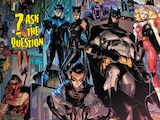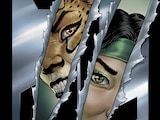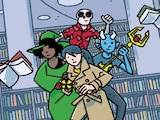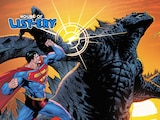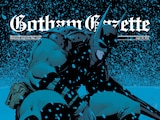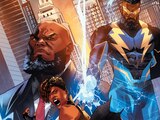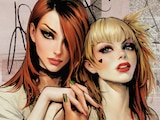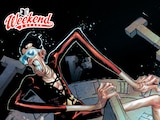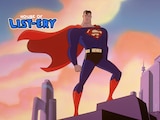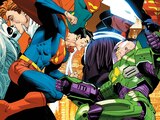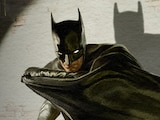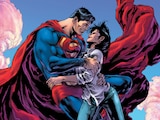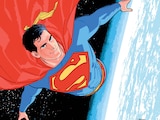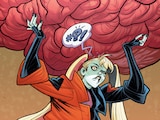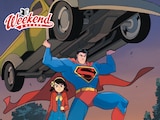DC Pride isn’t just a celebration of sexual and gender expression, it’s a salvo of love and acceptance in an ongoing culture war. And one of the most cathartic ways to fight back is a reclamation of symbology. In other words, taking the straightest, male gaze-oriented icons of our past, and queering them up for everybody.
One of the most recognizable movements in the American 20th century was the “pin-up model” culture of Rita Hayworth, Ava Gardner and Bettie Page—those women whose cheeky, demure posing was designed to “keep our boys flying” for a dream of the girls waiting for them back home.

In a Chicago convention hall in 2011, artist Ant Lucia reconceptualized the greatest heroines of the DC Universe using the style of pin-up models from the 1940s. One wildly popular collection of figurines later, comic writer Marguerite Bennett was tapped to develop these enticing visual takes into their own shared universe—a latter-day Elseworlds with glamorous heroines at the height of World War II. But instead of simply rehashing the pin-up aesthetic, Bennett used her series to recast the Bombshells from mere motivators to the fighters of the war itself, from the mortar heavy front lines to the spycraft of the back. These “Bombshells” were no mere models: they were heroes.
But as a queer author herself, it wasn’t simply enough for Marguerite Bennett to turn an emblem of straight male fantasy into feminine empowerment. These pin-up models, after all, were still inherently sexy. But what if we could take that imagery and make it queer? In this highly visible corner of the DC multiverse, Bennett would show us that sexual empowerment and confidence wasn’t merely for the benefit of a straight male audience. Women could love women too—and they did. In DC Comics: Bombshells and later in Bombshells: United, Marguerite Bennett took a world full of female heroes and filled it with romance…for each other. Here are just a few of our favorite love stories from a Sapphic planet.
Batwoman, Maggie Sawyer and Renee Montoya


In 2006, Greg Rucka and J.H. Williams III returned Batwoman to comics continuity as Kate Kane, an out and proud gay woman, reshaping a character introduced purely to reaffirm heteronormativity into a champion for queer representation. In DC Comics: Bombshells, Bennett puts the reclaimed Batwoman at the front and center of her historical drama as the closest thing to a protagonist the ensemble comic has. Here, Batwoman struggles with conflicted emotions regarding the flame of her past, Spanish revolutionary Renee Montoya, and her current girlfriend, GCPD detective Maggie Sawyer, both respectively reflecting her pre-Flashpoint and New 52 love interests.
In fiction, “queer erasure” is an all-too-common phenomenon where a gay character can be written out to make room for another, devaluing their purpose as anything more than a demographic filler. Bennett defies that notion. Both of the great loves of Kate Kane’s life have a role to play in Bombshells.
Hawkgirl and Vixen

Fans of the Justice League and Justice League Unlimited cartoons know Hawkgirl and Vixen as the dueling primary love interests of the Green Lantern, John Stewart. In this reinterpretation, Bombshells proposes a radical idea: why not cut out the middleman? In Bennett’s world, Mari was both the queen and an Olympic runner for the African nation of Zambesi. Shayera was a genius mechanic and archaeologist, investigating the legendary totems of Mari’s homeland. And from the moment they met, it was love at first sight. Together, this power couple fought against the third Reich from the beating heart of Africa, encouraged onward by the beats of their own. They even pull off the greatest heist against Adolf Hitler of all time: stealing and adopting his dog.
Big Barda and Doctor Light

One of the greatest stories of love and war in the history of the DC Universe is the tale of Big Barda. Indoctrinated from birth into Darkseid’s elite death squadron known as the Female Furies, it’s only the power of love which frees her from the bleak world of Apokolips. In Bombshells, Barda Free once again stands as a symbol for love in the time of war, but finds romance with one of her sisters in arms: Kimiyo Hoshi, with whom she works in administration for Commander Waller’s Bombshells. But when the chips are down, both prove powerful field assets in their own right. In Bombshells, even the scientists and security officers see action…in all senses of the term.
Supergirl and Eloisa Lane

The single most iconic romance in DC history is the love shared between Superman and Lois Lane. In Bombshells, however, it’s Supergirl who ends up sweeping Lois off her feet. Conjuring shades of Superman: Red Son, Kara Zor-El’s rocket first makes landfall in the Soviet Union, making her an asset to the Russian army. Facing lies for her entire life about who she truly was and her role in the grander scheme, it’s understandable that she would find love with this world’s version of Lois, who, as in every world, wages war with her pen as a soldier for truth above all else.
Wonder Woman and Mera

Bisexuality throughout Wonder Woman’s history has only recently started being acknowledged, but so far, most Wonder Woman stories have engaged with the subject fleetingly at best. Not so in Bombshells. Though Diana continues to pursue a blossoming relationship throughout the story with intelligence officer Steve Trevor, a close political friendship maintained between Themyscira and Atlantis eventually reveals its basis in a steamy affair between Diana and the sunken kingdom’s own Queen Mera. Who knows? Maybe if Diana had been betrothed to Mera instead of Aquaman in Flashpoint, events wouldn’t have broken so badly.
Batgirl (Alysia Yeoh) and Batgirl (Nell Little)

One of the best stories of this year’s DC Pride was “Up at Bat,” the long-awaited hero turn for Barbara Gordon’s former roommate Alysia Yeoh. But while Alysia’s creator Gail Simone had always intended her to find a place as the first trans woman in the Bat-Family, that dream would be unrealized by the end of her run on Batgirl. But before “Up at Bat” creative team Jadzia Axelrod and Lynne Yoshii got there, Bombshells beat them to the punch by introducing Alysia as part of a whole team of Batgirls. At the end of the war, we see her embarking on a new romantic journey with fellow Batgirl, Nell Little.
Harley Quinn and Poison Ivy


For decades after they first rode off together like Thelma and Louise in the Batman: The Animated Series episode “Harley and Ivy,” DC has upheld a long tradition of playing coy with the exact nature of Poison Ivy and Harley Quinn’s relationship. Years before their bombastic romance in the Harley Quinn animated series, Bombshells refused to engage in any such games. Here, the subtext is made plain text.
Though their relationship begins as flirtatiously as tradition has dictated, it’s soon clear that their love for one another is the only thing that makes sense in a world more chaotic than it had ever been before. And ultimately, it’s the power of that love which allows Harley to reject the Joker’s influence in her life—and grants HarlIvy their first kiss in any DC story ever told. If you’ve ever wanted to see a happy ending to Harley’s tragic story of misplaced faith and dire heartbreak, then Bombshells is where you’ll find it.

You may be reading all of this and thinking to yourself, “Is every single hero in Bombshells queer? I’m as open-minded as anybody, but isn’t that a little much?”
If that’s the case, I’d like you to indulge me in a thought experiment. Think about a story you’ve enjoyed where there were no queer people at all. A comic, a novel, a movie, a show, a video game where the only kind of romance ever expressed was between a cis man and a cis woman. I’ll bet it wasn’t very difficult to think of one because, when you take stock of all the media we have access to today, well…that’s most of them.
Now, as a queer person, what do you imagine it felt like to be surrounded by a culture like that? To be completely absent from every example of romance you were presented with? And as a straight person, what was it like to take that for granted—for every story you encountered to affirm your identity and orientation? Honestly think about it. Try to feel as someone else in those positions might, and see if you still have the same objections. See if you wouldn’t want a story every now and then, even just one in a hundred, which radically affirmed your own self-identity the way heterosexual lives are daily.
Is the all-encompassing queer love of DC Comics: Bombshells too much? I guess our answer to that question is a second one. What is an Elseworlds story, really, if not a reason to dream of another life?
Unfamiliar with the WWII-era adventures of the DC Bombshells? Both DC Comics: Bombshells and its follow-up, Bombshells: United, can be read in-full on DC UNIVERSE INFINITE.
Alex Jaffe is the author of our monthly "Ask the Question" column and writes about TV, movies, comics and superhero history for DCComics.com. Follow him on Twitter at @AlexJaffe and find him in the DC Community as HubCityQuestion.
NOTE: The views and opinions expressed in this feature are solely those of Alex Jaffe and do not necessarily reflect those of DC Entertainment or Warner Bros.

